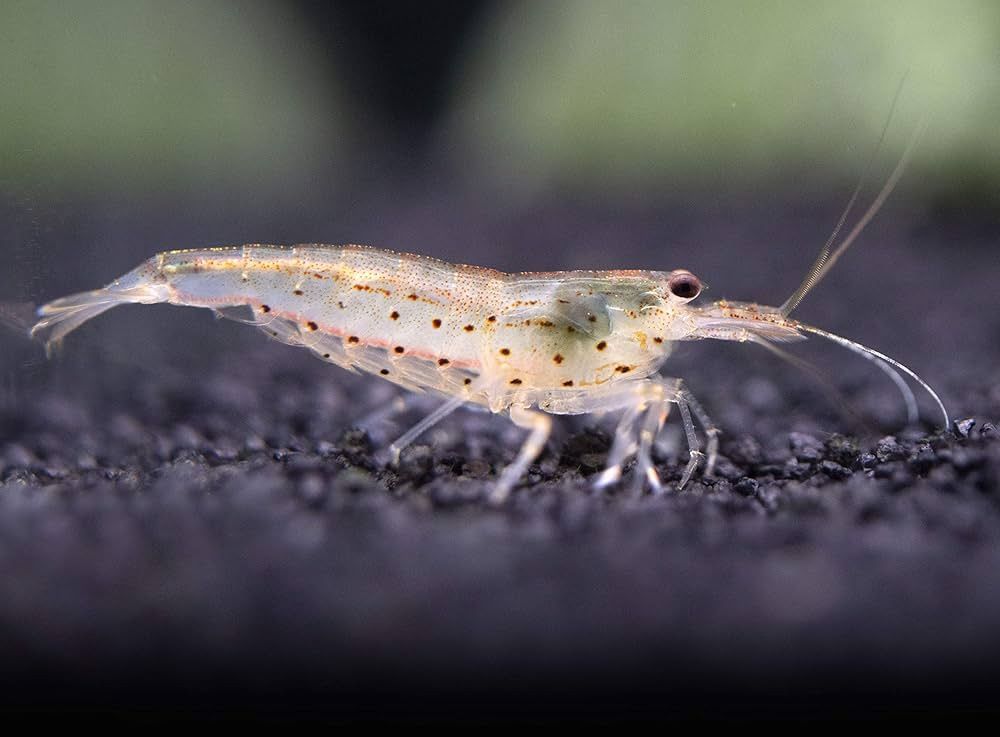Amano Shrimp
Amano Shrimp Care Guide
Amano Shrimp (Caridina multidentata) are popular freshwater shrimp known for their algae-eating abilities and peaceful nature. They are excellent tank cleaners and an interesting addition to a community aquarium. Here’s a complete care guide for Amano Shrimp:
1. Tank Setup
-
Tank Size: Amano shrimp can live in tanks as small as 10 gallons (38 liters), but larger tanks provide more stability and space for them to thrive.
-
Substrate: Amano shrimp prefer a soft substrate like fine gravel or sand to avoid injuring their delicate antennae and legs. They may sift through the substrate for food.
-
Aquascaping: These shrimp love a planted tank. Use live plants (such as Java moss, Anubias, or Java Fern) as they provide food, hiding spots, and surfaces for algae. They enjoy areas with rocks and driftwood to hide in.
-
Water Temperature: Keep the water temperature between 22°C and 26°C (72°F to 78°F). Avoid drastic temperature fluctuations.
-
Water pH: They do well in slightly acidic to neutral water, with a pH range of 6.5–7.5. They prefer soft water but can tolerate slightly harder water as long as it's not too extreme.
-
Filtration: Amano shrimp prefer gentle filtration to avoid being sucked into the filter. A sponge filter works well in shrimp tanks. They need good water flow but not too strong.
2. Diet
-
Omnivores: Amano shrimp are scavengers and eat a variety of foods, including algae, detritus, and leftover fish food. They are most famous for eating green spot algae, biofilm, and hair algae.
-
Supplementing Their Diet: While they are great algae eaters, it's important to supplement their diet with high-quality shrimp pellets, blanched vegetables (like zucchini, spinach, or cucumber), and flakes designed for shrimp. They also enjoy live foods like brine shrimp or daphnia.
-
Feeding Frequency: Feed them small amounts 2-3 times a week. They are excellent at foraging, so if you have algae in your tank, they may not need supplemental food every day.
-
Avoid Overfeeding: Overfeeding can lead to poor water quality. Amano shrimp are efficient eaters, so small, frequent feedings are best.
3. Tank Mates
-
Peaceful: Amano shrimp are peaceful and can be kept with many types of fish, including small to medium peaceful species like tetras, guppies, corydoras, and neon tetras.
-
Avoid Large or Aggressive Fish: Avoid keeping them with aggressive species or large fish that might eat them. Cichlids could potentially target Amano shrimp.
-
Other Invertebrates: They also get along well with other peaceful invertebrates, such as snails or other shrimp species, provided there’s enough food and space for everyone.
4. Behavior
-
Social Creatures: Amano shrimp are very social and feel more comfortable in groups. It’s ideal to keep them in groups of at least 4–6 shrimp.
-
Active Cleaners: They spend most of their time foraging for food, especially algae and detritus. They are often seen grazing on plants, rocks, and tank decorations.
-
Molting: Amano shrimp molt (shed their exoskeleton) regularly as they grow. This process typically happens every 3-6 weeks. After molting, they may be a bit vulnerable, so providing plenty of hiding spots is important.
-
Hiding Spots: These shrimp enjoy hiding in plants, decorations, and cracks in rocks. Adding more hiding spaces helps reduce stress, especially during molting.
5. Water Quality & Maintenance
-
Ammonia and Nitrite: Like all shrimp, Amano shrimp are highly sensitive to ammonia and nitrites. Ensure these are always at 0 ppm (parts per million).
-
Nitrate Levels: Keep nitrates below 20 ppm. Regular water changes (20–30% weekly) will help maintain water quality and reduce excess nitrates.
-
Hard Water: Amano shrimp can tolerate moderate water hardness but prefer soft water for molting. If your water is too hard (high in calcium and magnesium), the shrimp may struggle to molt properly.
-
Water Temperature: Keep the temperature stable, as sudden fluctuations can stress the shrimp and make them more susceptible to disease.
6. Breeding
-
Breeding Difficulty: Amano shrimp are difficult to breed in freshwater tanks. They require brackish water (slightly salty water) for successful breeding. The females will release eggs that must hatch in saltwater to survive.
-
Larvae: The larvae will need brackish water conditions for several weeks before transitioning to freshwater. Since this can be challenging for most aquarium setups, it’s not common for hobbyists to successfully breed Amano shrimp without specialized tanks.
-
Egg Carrying: Female Amano shrimp will carry their fertilized eggs under their abdomen. These eggs are usually yellow or greenish.
7. Health & Monitoring
-
Signs of Stress: If your Amano shrimp are not moving, have faded color, or have abnormal postures (such as curling), they may be stressed or unhealthy. Check your water quality, temperature, and tankmates for any issues.
-
Common Illnesses: Amano shrimp are susceptible to bacterial infections, fungal diseases, or shell rot if water quality is poor. Maintaining clean water and a stress-free environment is key to preventing illness.
-
Molting: As mentioned, shrimp molt regularly. If you notice that your shrimp isn’t molting, it could indicate a problem, such as poor water quality, lack of calcium, or stress.
8. Lighting and Aquascaping
-
Lighting: Amano shrimp don’t require special lighting. Moderate lighting works well for both plants and shrimp. Too much light can cause excessive algae growth, which might stress the shrimp if they can’t keep up.
-
Plants: Amano shrimp do best in a planted tank where they can forage for algae and biofilm. Fast-growing plants are excellent for providing them with constant food sources.
Final Thoughts:
Amano shrimp are fantastic additions to planted tanks, offering both aesthetic appeal and practical benefits by helping to control algae. They're peaceful, social, and relatively easy to care for if you maintain good water quality and provide adequate food sources. Just keep an eye on their molting process, as it can be a vulnerable time for them.

